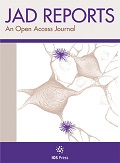Authors: Madsen, Steven J. | DiGiacomo, Phillip S. | Zeng, Yitian | Goubran, Maged | Chen, Yuanxin | Rutt, Brian K. | Born, Donald | Vogel, Hannes | Sinclair, Robert | Zeineh, Michael M.
Article Type:
Research Article
Abstract:
Background: Recent evidence suggests that the accumulation of iron, specifically ferrous Fe2+ , may play a role in the development and progression of neurodegeneration in Alzheimer’s disease (AD) through the production of oxidative stress. Objective: To localize and characterize iron deposition and oxidation state in AD, we analyzed human hippocampal autopsy samples from four subjects with advanced AD that have been previously characterized with correlative MRI-histology. Methods: We perform scanning electron microscopy (SEM), energy dispersive spectroscopy (EDS), and electron energy loss spectroscopy (EELS) in the higher resolution transmission electron microscope on the surface and cross-sections of
…specific iron-rich regions of interest. Results: Specific previously analyzed regions were visualized using SEM and confirmed to be iron-rich deposits using EDS. Subsequent analysis using focused ion beam cross-sectioning and SEM characterized the iron deposition throughout the 3-D volumes, confirming the presence of iron throughout the deposits, and in two out of four specimens demonstrating colocalization with zinc. Analysis of traditional histology slides showed the analyzed deposits overlapped both with amyloid and tau deposition. Following higher resolution analysis of a single iron deposit using scanning transmission electron microscope (STEM), we demonstrated the potential of monochromated STEM-EELS to discern the relative oxidation state of iron within a deposit. Conclusion: These findings suggest that iron is present in the AD hippocampus and can be visualized and characterized using combined MRI and EM techniques. An altered relative oxidation state may suggest a direct link between iron and oxidative stress in AD. These methods thus could potentially measure an altered relative oxidation state that could suggest a direct link between iron and oxidative stress in AD. Furthermore, we have demonstrated the ability to analyze metal deposition alongside commonly used histological markers of AD pathology, paving the way for future insights into the molecular interactions between Aβ, tau, iron, and other putative metals, such as zinc.
Show more
Keywords: Alzheimer’s disease, correlative microscopy, histopathology, iron, neuroinflammation, oxidative stress, specimen MRI
DOI: 10.3233/ADR-200234
Citation: Journal of Alzheimer's Disease Reports,
vol. 4, no. 1, pp. 525-536, 2020





